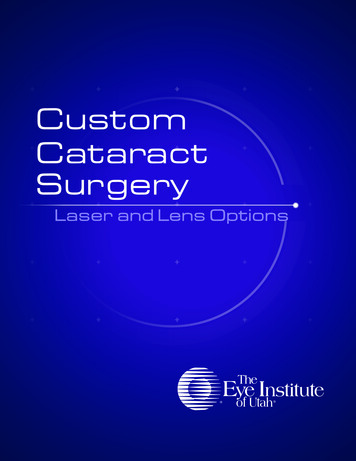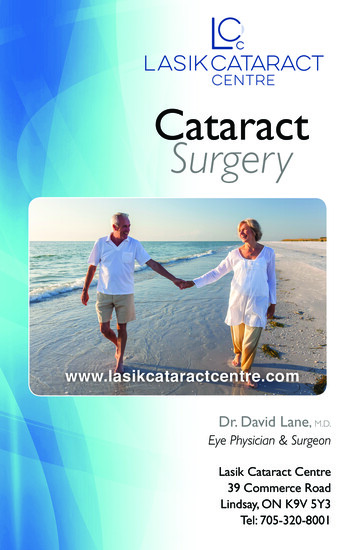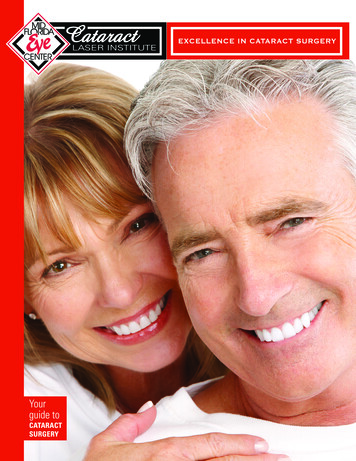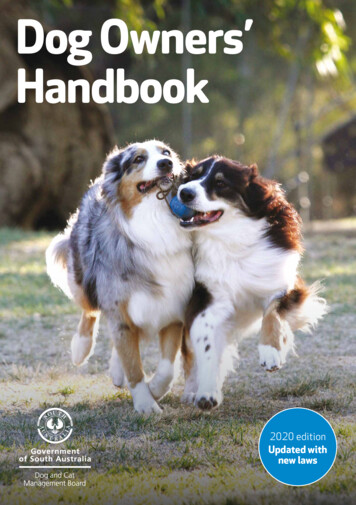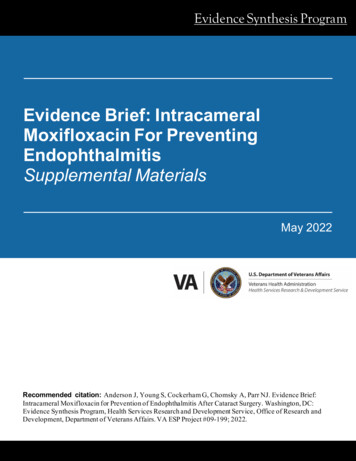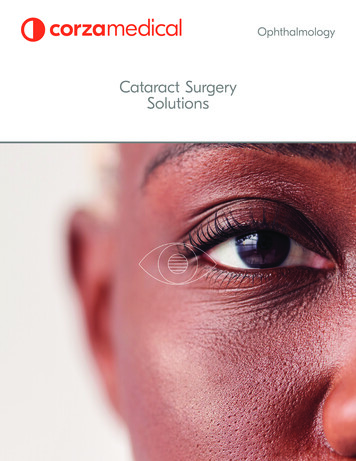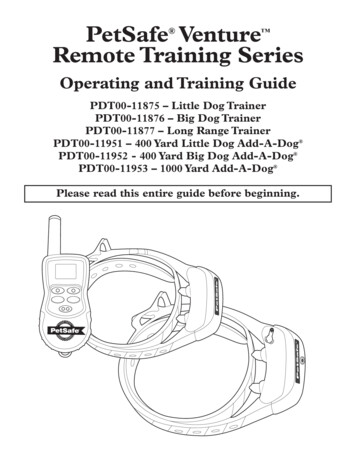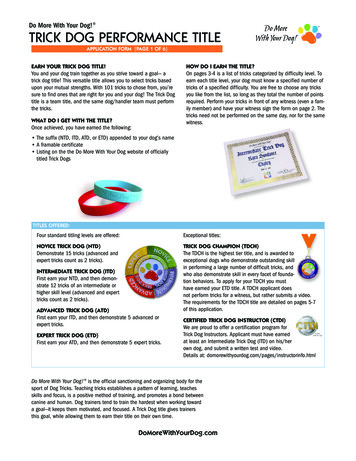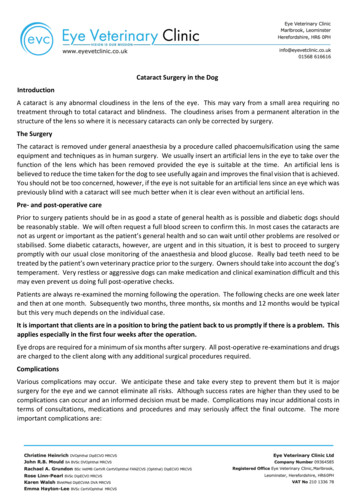
Transcription
Cataract Surgery in the DogIntroductionA cataract is any abnormal cloudiness in the lens of the eye. This may vary from a small area requiring notreatment through to total cataract and blindness. The cloudiness arises from a permanent alteration in thestructure of the lens so where it is necessary cataracts can only be corrected by surgery.The SurgeryThe cataract is removed under general anaesthesia by a procedure called phacoemulsification using the sameequipment and techniques as in human surgery. We usually insert an artificial lens in the eye to take over thefunction of the lens which has been removed provided the eye is suitable at the time. An artificial lens isbelieved to reduce the time taken for the dog to see usefully again and improves the final vision that is achieved.You should not be too concerned, however, if the eye is not suitable for an artificial lens since an eye which waspreviously blind with a cataract will see much better when it is clear even without an artificial lens.Pre- and post-operative carePrior to surgery patients should be in as good a state of general health as is possible and diabetic dogs shouldbe reasonably stable. We will often request a full blood screen to confirm this. In most cases the cataracts arenot as urgent or important as the patient’s general health and so can wait until other problems are resolved orstabilised. Some diabetic cataracts, however, are urgent and in this situation, it is best to proceed to surgerypromptly with our usual close monitoring of the anaesthesia and blood glucose. Really bad teeth need to betreated by the patient’s own veterinary practice prior to the surgery. Owners should take into account the dog’stemperament. Very restless or aggressive dogs can make medication and clinical examination difficult and thismay even prevent us doing full post-operative checks.Patients are always re-examined the morning following the operation. The following checks are one week laterand then at one month. Subsequently two months, three months, six months and 12 months would be typicalbut this very much depends on the individual case.It is important that clients are in a position to bring the patient back to us promptly if there is a problem. Thisapplies especially in the first four weeks after the operation.Eye drops are required for a minimum of six months after surgery. All post-operative re-examinations and drugsare charged to the client along with any additional surgical procedures required.ComplicationsVarious complications may occur. We anticipate these and take every step to prevent them but it is majorsurgery for the eye and we cannot eliminate all risks. Although success rates are higher than they used to becomplications can occur and an informed decision must be made. Complications may incur additional costs interms of consultations, medications and procedures and may seriously affect the final outcome. The moreimportant complications are:
InflammationAll eyes become inflamed after surgery and in most cases this is controllable by medication. Some dogs releasea substance called fibrin into the eye which can have harmful consequences. When this occurs it is usually inthe first four weeks post-operatively. Fibrin can be dissolved by injection of the enzyme TPA into the eye undersedation and local anaesthetic. TPA is required in 15% of all eyesGlaucomaGlaucoma is a raised pressure in the eye and is always potentially serious. We measure the pressure in the eyeat the first consultation and at all subsequent ones as it is important to monitor it. We identify dogs atexceptional risk of glaucoma by a test called gonioscopy performed at the initial consultation but some risk ofglaucoma is present in all dogs.Problems with pressure tend to occur in two situations: The immediate post-operative period, usually the same day or the first 24 hours. Some dogs sustainhigh pressures in this period. Although this is usually a temporary problem we take it seriously and mayneed to take emergency measures to bring the pressure down. Longer term. Longer term pressure rise is the most serious complication seen. It may cause pain andimpair or destroy the patient’s sight. This will require ongoing medication and anti-glaucoma drugs arerelatively expensive.Where there are unmanageable complications which are causing pain, despite everyone’s best efforts, the mosteffective means of pain relief may be removal of the eye. Chronic glaucoma is the most common cause. Eyeremoval is eventually required in 3% of all eyes undergoing cataract surgery.Lens regrowth“Can the cataract grow back?” is a logical question to ask before cataract surgery. Some lens cells are alwaysleft behind at the time of the operation and so some lens regrowth is quite common. In most cases, however,it is not vigorous and does no harm. In some cases it regrows out of control and can cause inflammation, reclouding of the eye and other serious complications. If this is happening the regrowth needs to be removedunder general anaesthesia. This procedure is simpler and shorter than the original cataract operation. It isunusual to need to repeat it. This procedure is much more common in young dogs and owners of young dogsshould allow for the possibility of the additional cost.Other complicationsOther uncommon but serious complications include intraocular haemorrhage, intraocular infection and retinaldetachment, all of which may be difficult to manage.SummaryClients need to be aware of all that is involved so that they can make an informed choice, weighing potentialbenefits against risks. With the modern methods of cataract surgery success rates are much higher than witholder methods. With an incurable problem and a high success rate for the operation clients can embark oncataract surgery with as much confidence as with many other operations commonly performed on dogs.
Cataract Surgery at Eye Veterinary ClinicThis is a quick check-list to help you with your planning for your dog’s cataract surgery. Location - All our surgery takes place at:Eye Veterinary ClinicMarlbrookLeominsterHerefordshireHR6 0PHinfo@eyevetclinic.co.ukwhere we have the trained staff and facilities. The number for all communications including out-clinic appointments and emergencies is01568 616616.We are not in Leominster itself but on the A49 next to the Marlbrook roundabout 4 miles south ofLeominster and 8 miles north of Hereford. If you use SatNav be sure to enter HR6 0PH.Additional drops will be given when your dog arrives and then the ultrasound scan will be performedwhile you are still present, and you can be with your dog for this.Post-operatively we need to monitor the eyes closely for the rest of the day particularly the pressure. Ifthe pressure rises dangerously then additional drops or procedures may be necessary.Dogs are very welcome to stay with us overnight, but we recommend that they do not stay in the hospitalas they are usually much happier with their owners. We will liaise with you on the day about timings ifyou are collecting them. If a dog is very agitated with us, we may have to ask that your pet spends thenight with you where it will be calmer. In some cases, we may call owners back to sit with a restless dogduring the day. Constant barking and excitement can be dangerous for the eyes.We have a list of dog-friendly B & Bs nearby for owners who wish to reduce their travelling or have thedog with them for the night if they cannot get home.All dogs need to be seen for:o 24 hour post-op check the following morning if they have not spent the night in the hospital.o Next check 5-7 days post-op. For clients who attend one of our out clinics it is still preferable ifthis check is done at Leominster. Please discuss this with us.Subsequently one month, three months, six months and 12 months would be typical, but this very muchdepends on the individual case.It is important to allow for these checks in your planning. If there are problems with the eyes then additionalappointments may be necessary.Our nurses are very experienced in arranging cataract surgery and can answer most questions themselves orrefer you to one of the vets if necessary. Feel free to ask our nurses any questions that you may have. We arehere to help.
Prices for Cataract Surgery from January 2021 (prices subject to review)The cost of surgery includes examination at 24hrs and 7 days after surgery. Further examinations are chargedat 140.00. The prices quoted are for animals up to 10kg. A surcharge of 4.04 per kg is made for heavieranimals due to extra anaesthesia costs.Summary of costs for an uncomplicated cataract surgery (dogs up to 10Kg)One EyeBoth eyesInitial consultation 210 210GonioscopyIncludedIncludedUltrasound scan 237.00 237.00Cataract removal one eye (inc lens) 2949.80n/aCataract removal both eyes (inc lens)n/a 4101.60Average cost of post-op drugs 155 155Re-examinations(minimum of 3) 420 420Total 3971.80 5123.60AssessmentDay of SurgeryThis is for the uncomplicated case. Any complications may require additional consultations,procedures, hospitalisation and drugs at our standard charges.Some patients require the following additional procedures:Electroretinography 527.50Vitrectomy (may be necessary during surgery) 283.00For uncomplicated cases you should budget for at least three further re-examinations ( 140 each visit), plusany drugs that your pet may require for the next 6 months.We are always happy to provide written prescriptions to help keep costs as low as possible.
Current Charges and Financial ArrangementsFrom January 2021. These charges and arrangements are subject to review without notice.ConsultationsInitial consultation 210Re-examination 140Initial consultation out of hours 335Re-examination out of hours 252Nurse call in fee for consultations 80Nurse call in fee for surgery 130Out-of-hours examinations incur an additional fee for attendance of a veterinary nurse and out-of-hourssurgery also incurs an additional fee as detailed above.InsuranceInsurance claim administration fee per form 11.85Direct claim administration fee per form 34.00This charge covers the administration costs of completing each insurance form. This fee will not be reclaimablefrom the insurance company. After completion we are required to return claim forms to the client for onwardsubmission to the insurance company.We ask that all accounts are settled by the client at the time of the consultation or procedure. We will processyour claim form as quickly as possible. In exceptional circumstances we will submit direct claims to insurancecompanies for surgery invoices only but not for drugs or consultations. Any such direct claim must be authorisedby our staff in advance. Clients should be aware that any excesses payable remain their liability.PrescriptionsPrescription Fee 1 item 17.00Prescription Fee 2 items 19.85Prescription Fee 3 items 22.75
Eye Veterinary Clinic Marlbrook Leominster Herefordshire HR6 0PH info@eyevetclinic.co.uk where we have the trained staff and facilities. The . The cost of surgery includes examination at 24hrs and 7 days after surgery. Further examinations are charged at 140.00. The prices quoted are for animals up to 10kg.
